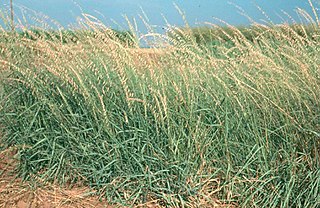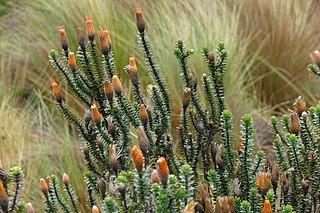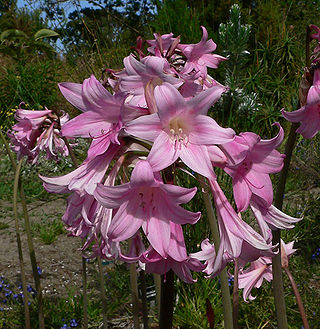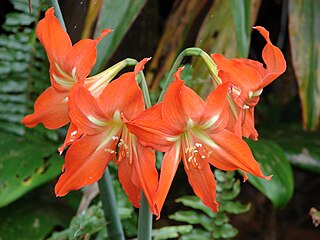
Senecio is a genus of flowering plants in the daisy family (Asteraceae) that includes ragworts and groundsels.

Palafoxia, or palafox, is a genus of North American flowering plants in the Bahia tribe within the Asteraceae.

Eriophyllum, commonly known as the woolly sunflower, is a North American genus of plants in the family Asteraceae. The genus is native to western North America, with a concentration of narrow endemics in California.
Martín Sessé y Lacasta was a Spanish botanist, who relocated to New Spain during the 18th century to study and classify the flora of the territory. The standard author abbreviation Sessé is used to indicate this person as the author when citing a botanical name.

Thespesia grandiflora, most commonly known as Maga, and also referred to as Maga Colorada and Puerto Rican hibiscus, is a tree in the family Malvaceae of the rosids clade endemic to Puerto Rico, where its flower is officially recognized as the national flower of the archipelago. Although originally native to the humid mountains of limestone in the western and north-central portions of Puerto Rico, today it grows everywhere in the archipelago due to its extensive cultivation. It is also grown as an ornamental tree in Florida, Hawaii, Honduras and various Caribbean islands. The maga is mostly used as an ornamental plant, but like the related Thespesia populnea its wood is also valued for its durable timber.

Bouteloua is a genus of plants in the grass family. Members of the genus are commonly known as grama grass.

Real Jardín Botánico de Madrid is an 8 hectares botanical garden in Madrid (Spain). The public entrance is located at Plaza de Murillo, next to the Prado Museum.

Chuquiraga is a genus of flowering plants in the family Asteraceae. The genus is distributed in the Andes from Colombia to Chile, with most species occurring in Patagonia.

Gutierrezia is a genus of flowering plants in the family Asteraceae, native to western North America and western South America. Plants of this genus are known generally as snakeweeds or matchweeds. Some species have been called greasewood. They are annual or perennial plants or subshrubs with yellow or white flowers.

Podanthus is a genus of Chilean plants in the tribe Heliantheae within the family Asteraceae.

Carduncellus is a genus of flowering plants in the tribe Cardueae within the family Asteraceae. They are native to the western Mediterranean and surrounding regions.

The Amaryllidaceae are a family of herbaceous, mainly perennial and bulbous flowering plants in the monocot order Asparagales. The family takes its name from the genus Amaryllis and is commonly known as the amaryllis family. The leaves are usually linear, and the flowers are usually bisexual and symmetrical, arranged in umbels on the stem. The petals and sepals are undifferentiated as tepals, which may be fused at the base into a floral tube. Some also display a corona. Allyl sulfide compounds produce the characteristic odour of the onion subfamily (Allioideae).

Hippeastreae is a tribe of plants belonging to the subfamily Amaryllidoideae of the Amaryllis family (Amaryllidaceae). Species in this tribe are distributed in South America. Flowers are large and showy, zygomorphic, with the stamens in varying lengths, inflorescence bracts are often fused basally. The seeds are flattened, winged or D-shaped. Reported basic chromosome numbers are x= 8-13, 17, and higher. All the species in this tribe present a remarkable aesthetic interest and horticultural value.

Traubia is a genus of Chilean plants in the Amaryllis family. Only one species is recognized, Traubia modesta, native to northern and central Chile.

Narcisseae is a small tribe of plants belonging to the subfamily Amaryllidoideae of the Amaryllis family (Amaryllidaceae), where it forms part of the Eurasian clade, and is one of three tribes in the European (Mediterranean) clade. It contains two genera and approximately 58 species, but probably also Lapiedra. The two genera are distinguished from each other by the presence of a paraperigonium in the former.

The taxonomy of Narcissus is complex, and still not fully resolved. Known to the ancients, the genus name appears in Graeco-Roman literature, although their interest was as much medicinal as botanical. It is unclear which species the ancients were familiar with. Although frequently mentioned in Mediaeval and Renaissance texts it was not formally described till the work of Linnaeus in 1753. By 1789 it had been grouped into a family (Narcissi) but shortly thereafter this was renamed Amaryllideae, from which comes the modern placement within Amaryllidaceae, although for a while it was considered part of Liliaceae.

Narcissus broussonetii is a species of the genus Narcissus (daffodils) in the family Amaryllidaceae. It is classified in Section Aurelia. It is native to North Africa.

Kanasín is a city in the Mexican state of Yucatán and the municipal seat of the municipality of the same name. It is located in the northwestern region of the state, forming part of the Mérida metropolitan area. According to the 2020 census carried out by the National Institute of Statistics and Geography (INEGI), it had a population of 139,753, making it the second largest Yucatecan city after Mérida, the 8th most populous in southeastern Mexico and the 101st most populous in the country.
















